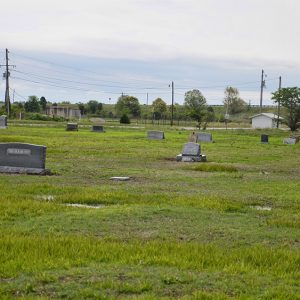calsfoundation@cals.org
Scott Cemetery
Scott Cemetery, established in 1920, is located in rural Lawrence County near Walnut Ridge (Lawrence County). The cemetery is representative of many small, rural African-American cemeteries in the South, although it is not associated with a nearby church. There are approximately 101 graves in the cemetery, including those of former slaves and of several leaders of the African-American community in the area. Scott Cemetery was listed in the National Register of Historic Places under Criterion A, with local significance for its association with the ethnic heritage (burial customs) of the African-American community of Walnut Ridge, Hoxie (Lawrence County), and the surrounding portions of Lawrence County from the 1920s to the present.
Scott Cemetery is one of seven African-American cemeteries within Lawrence County and is the only one located in the vicinity of Walnut Ridge. Scott Cemetery follows the model of the rural African-American cemetery that developed during the Jim Crow era as part of the black community’s efforts to create its own institutions. The cemetery has remained an important cultural touchstone for the local black community since its founding, evidenced by fact that, from the 1960s to the present, many residents who moved away from the area in their adulthood have asked to be buried at Scott Cemetery.
Unlike many rural cemeteries, Scott Cemetery is not associated with a church or fraternal organization. The first mention of the cemetery is a September 1920 deed in which T. J. Sharum deeded one acre of land for $200 to Scott Cemetery, with Moses Scott as president of the trust and W. M. Woods, James Jefferson, Thomas Wiley, Will Howard, and Evry Hunt as trustees. While much is known about Sharum, less is known about the other African-American men who purchased the land in 1920 to be used as a cemetery. Moses Scott, president of the trust, is listed on the 1920 census as a fifty-six-year-old gardener who worked for a local “truck patch,” or market garden. The rest of the trustees were African-American men with steady jobs (not sharecroppers). Also, all the men were literate and would have been in a position to understand the written rules and documents.
After establishment of the cemetery, records indicate it was quickly used. Flora Scott, the wife of Moses Scott, was probably the first person buried in the cemetery, in 1922. Over the next several decades, the cemetery averaged one burial a year.
The Hill Foundation began conducting biannual cleanups of the cemetery, as well as repairing and replacing grave markers. As part of the preservation efforts, the Hill Foundation requested that the Arkansas Archeological Survey examine the cemetery in 2005. Scott Cemetery was recorded as an archeological site (3LW745), and the Arkansas Archeological Survey performed a geophysical survey of the cemetery to map it and investigate the possibility of unmarked graves.
Scott Cemetery serves as the final resting place for at least seven former slaves, as well as local leaders in the area’s black community. It was listed on the National Register of Historic Places on June 5, 2017.
For additional information:
“The Integration of Hoxie: A Panel Discussion.” Arkansas Review: A Journal of Delta Studies 35 (December 2004): 188–203.
Jared, George. “A Labor of Love: Restoration of Lawrence County Cemetery Becomes Passion.” Jonesboro Sun, December 25, 2008.
Lockhart, Jami J., Michael Evans, Julie Morrow, John Samuelsen, Kathy Cande, and Shaun McGahay. Scott Cemetery, Walnut Ridge, AR, Archaeogeophysical Remote Sensing Survey. Arkansas Archeological Survey, December 13, 2007.
“Scott Cemetery.” National Register of Historic Places registration form. On file at Arkansas Historic Preservation Program, Little Rock, Arkansas. Online at http://www.arkansaspreservation.com/National-Register-Listings/PDF/LW0197_nr.pdf (September 19, 2017).
Edward Salo
Arkansas State University
 Early Twentieth Century, 1901 through 1940
Early Twentieth Century, 1901 through 1940 Historic Preservation
Historic Preservation Scott Cemetery
Scott Cemetery  Scott Cemetery
Scott Cemetery 



Comments
No comments on this entry yet.